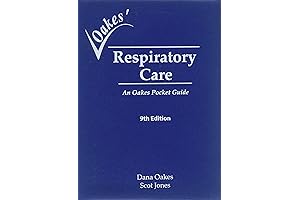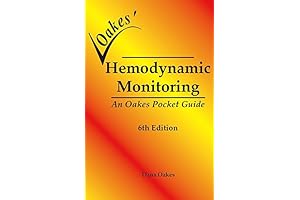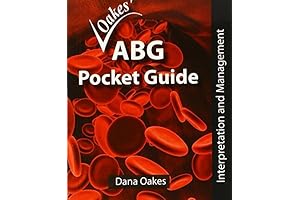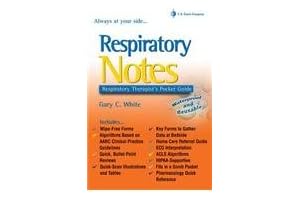· respiratory care · 9 min read
The Best Respiratory Pocket Guides: Nurturing Your Respiratory Skills
Unveiling the top-rated Respiratory Pocket Guides, meticulously designed to empower respiratory therapists and healthcare professionals. Discover the essential guide that aligns with your practice.
Welcome to the realm of respiratory care, where knowledge is paramount. As a respiratory therapist or healthcare professional, navigating the complexities of respiratory care demands a reliable and accessible resource. Our comprehensive guide showcases the best Respiratory Pocket Guides that will elevate your understanding, enhance your practice, and empower you to deliver exceptional patient care.
Overview

PROS
- Delivers quick and reliable respiratory care guidance at your fingertips.
- Compact and portable, making it an accessible resource in various settings.
- Provides valuable information on respiratory medications, disorders, and treatments.
CONS
- May lack the depth and detail of larger textbooks.
- May not be suitable for advanced practitioners requiring extensive knowledge.
The Respiratory Care: An Oakes Pocket Guide is an indispensable tool for respiratory therapists, nurses, and students seeking a concise and portable reference. Its well-organized format and user-friendly design make it easy to navigate and find the information you need quickly.
One of the standout features of this pocket guide is its comprehensive coverage of respiratory medications. It provides detailed information on each medication, including indications, dosages, side effects, and nursing considerations. This makes it an invaluable resource for those involved in medication management.

PROS
- Provides quick access to vital information for respiratory care providers.
- Covers a wide range of neonatal and pediatric respiratory topics.
- Features easy-to-follow algorithms and tables for quick reference.
- Compact and portable for convenient use at the bedside.
CONS
- Limited in-depth coverage of some topics.
- May not be comprehensive enough for advanced practitioners.
Oakes' Neonatal/Pediatric Respiratory Pocket Guide is a concise and practical resource for respiratory care providers working with infants and children. It offers a comprehensive overview of respiratory care topics, including assessment, monitoring, and management of common respiratory conditions. The pocket guide features a user-friendly format with bulleted lists, tables, and algorithms, making it easy to find the information you need quickly at the bedside.
The content is evidence-based and up-to-date, ensuring that you have access to the latest best practices. The pocket guide is also well-organized, with color-coded sections for different topics, making it easy to navigate. One potential drawback is that the pocket guide may not provide enough in-depth coverage for advanced practitioners, who may need more detailed information on specific topics. Additionally, some users may find the font size to be too small, especially for those with low vision.

PROS
- Provides essential information on neonatal and pediatric respiratory care
- Concise and portable format for quick reference
- Written by experienced respiratory care practitioners
- Covers a wide range of topics, including assessment, monitoring, and treatment
CONS
- May lack some advanced or specialized information
- Some users may prefer a more comprehensive textbook
The Oakes' Neonatal Pediatric Respiratory Care Pocket Guide is a valuable resource for respiratory care practitioners working with infants and children. It provides concise and up-to-date information on a wide range of topics, including assessment, monitoring, and treatment. The pocket-sized format makes it easy to carry and reference during clinical practice.
This guide is written by experienced respiratory care practitioners and is based on the latest evidence-based practice. It covers essential topics such as respiratory anatomy and physiology, respiratory assessment, oxygen therapy, mechanical ventilation, and respiratory emergencies. The content is presented in a clear and organized manner, with helpful tables, diagrams, and algorithms. Additionally, the guide includes information on specific respiratory conditions commonly seen in neonatal and pediatric patients.

PROS
- Delivers clear and concise coverage of essential respiratory care topics.
- Provides quick access to vital information in a portable format.
CONS
- Limited in-depth coverage for complex respiratory care situations.
- May require additional resources for comprehensive respiratory care knowledge.
Mosby's PDQ for Respiratory Care is an invaluable tool for respiratory therapists and students alike. Its pocket-sized format makes it highly portable, ensuring quick access to crucial information at the point of care. The content is meticulously organized and presented in a clear, concise manner, covering various respiratory care topics, including assessment, diagnosis, and management of respiratory conditions. The inclusion of tables, figures, and algorithms further enhances the accessibility and practicality of the guide.
While Mosby's PDQ for Respiratory Care excels in delivering essential respiratory care information, it may have some limitations for individuals seeking in-depth coverage of complex respiratory care scenarios. Additionally, respiratory therapists with extensive experience may find the content somewhat basic and may require supplemental resources for comprehensive knowledge. Nonetheless, for quick reference and as a foundation for respiratory care practice, Mosby's PDQ for Respiratory Care remains a highly recommended resource.

PROS
- Comprehensive coverage of respiratory care topics.
- Quick and easy access to essential information.
CONS
- May not be suitable for advanced practitioners.
Respiratory Notes: Respiratory Therapist's Pocket Guide is an invaluable resource for respiratory therapists and students. It provides concise yet comprehensive coverage of a wide range of respiratory care topics, from basic anatomy and physiology to advanced therapeutic interventions. The pocket-sized format makes it easy to carry around and quickly access information when needed.
One of the strengths of this guide is its organization. The information is presented in a logical and easy-to-navigate manner, with chapters covering different aspects of respiratory care. Each chapter is further divided into sections, making it easy to find specific information. The guide also includes numerous tables and figures, which help to illustrate complex concepts and provide a quick overview of key data.

PROS
- Succinct, easy-to-read format perfect for quick reference during critical care situations.
- Up-to-date information on hemodynamic monitoring and management techniques.
CONS
- Some users reported missing information on specific hemodynamic parameters.
- Lacks in-depth coverage of advanced hemodynamic monitoring techniques.
The Oakes' Hemodynamic Monitoring Pocket Guide is a valuable resource for clinicians involved in hemodynamic management. Its compact size makes it easily accessible in high-pressure situations, providing quick reference to essential information. The guide is well-organized, covering topics such as hemodynamic parameters, waveform analysis, invasive and non-invasive monitoring techniques, and pharmacological interventions.
Overall, the Oakes' Hemodynamic Monitoring Pocket Guide is a useful tool for clinicians seeking a practical and up-to-date reference on hemodynamic monitoring and management. However, it may not be sufficient as a sole source of information for advanced or specialized hemodynamic monitoring scenarios.

PROS
- Concise and user-friendly guide for interpreting arterial blood gases (ABGs)
- Clear and step-by-step approach to ABG analysis, including comprehensive explanations of pH, PaCO2, and HCO3-
CONS
- May be too basic for advanced healthcare professionals
- Lacks in-depth discussion of advanced ABG concepts
Oakes' ABG Pocket Guide is a must-have resource for healthcare professionals seeking to enhance their understanding and interpretation of arterial blood gases (ABGs). This pocket-sized guide provides a concise and user-friendly approach to ABG analysis, making it an ideal quick reference for busy clinicians. Dana Oakes' expertise in respiratory physiology shines through in the clear and step-by-step explanations of pH, PaCO2, and HCO3-, empowering readers to confidently assess and manage acid-base disorders.
The ABG Pocket Guide stands out for its practical and accessible approach. It offers a structured framework for interpreting ABGs, with straightforward algorithms and helpful tables that simplify complex concepts. This guide is particularly valuable for healthcare professionals new to ABG interpretation or those seeking a refresher. However, more experienced professionals may find the content somewhat basic and lacking in-depth discussions of advanced ABG concepts.

PROS
- Comprehensive coverage of respiratory therapy topics for quick access
- Up-to-date information aligns with current clinical practices and guidelines
CONS
- May require additional resources for more complex cases
Respiratory Notes: Respiratory Therapist's Pocket Guide is an invaluable resource for respiratory therapists seeking efficient and precise information. Its compact size and clear organization make it an ideal quick reference guide for both students and seasoned practitioners.
The guide covers a vast spectrum of respiratory topics, from basic respiratory physiology to advanced mechanical ventilation, ensuring that users have the latest knowledge at their fingertips. Its precise format allows for rapid identification of the required information, streamlining critical decision-making processes and fostering confident patient care.
In this thorough guide, we have meticulously curated the best Respiratory Pocket Guides to assist you in mastering the intricacies of respiratory care. These indispensable guides provide a wealth of knowledge at your fingertips, covering fundamental concepts, advanced techniques, and critical information. Whether you're a seasoned professional seeking to refine your skills or a novice eager to establish a solid foundation, these pocket guides are your trusted companions.
Frequently Asked Questions
What is the most comprehensive Respiratory Pocket Guide available?
Our top recommendation is Respiratory Care: An Oakes Pocket Guide, renowned for its comprehensive coverage and practical insights.
Which pocket guide is ideal for neonatal and pediatric respiratory care?
For specialized guidance in neonatal and pediatric respiratory care, Oakes' Neonatal/Pediatric Respiratory Pocket Guide is an excellent choice.
Can I find a pocket guide that focuses on respiratory notes and interpretation?
Yes, Respiratory Notes: Respiratory Therapist's Pocket Guide (Davis's Notes) is specifically designed to provide quick access to respiratory notes and interpretation techniques.
Is there a pocket guide that covers hemodynamic monitoring?
Oakes' Hemodynamic Monitoring Pocket Guide. 6E 2017 is a valuable resource for healthcare professionals seeking guidance on hemodynamic monitoring techniques.
Which pocket guide is recommended for ABG interpretation?
For expert guidance on ABG interpretation and management, Oakes' ABG Pocket Guide: Interpretation and Management by Dana Oakes is highly recommended.











